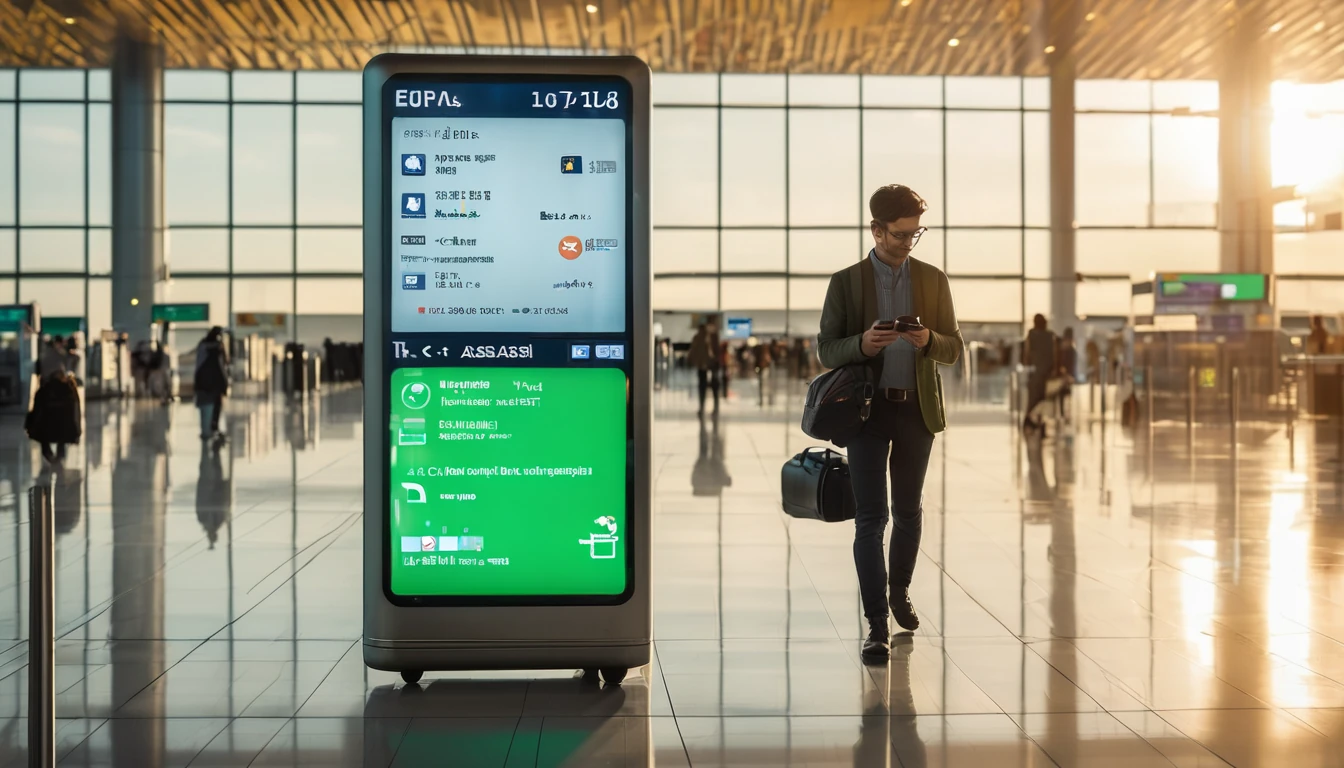Planning a long stretch around Europe? Here’s the traveller‑first guide to EU fair use on long stays. Confusion often comes from mixing two different systems: immigration rules (the Schengen 90/180‑day stay limit) and telecom rules (EU roaming fair use). They are not the same. Immigration limits how long you can stay. Telecom fair use limits how long you can roam on an EU plan before surcharges kick in. If you’re a student with local residency, you’re treated differently to a roaming nomad bouncing between countries. And regional eSIMs add a third option that avoids most “home vs abroad” checks altogether. This guide cuts through the jargon with plain‑English explanations, examples you can copy, and practical checklists to keep your connectivity clean and cost‑predictable. If you just want a solution: country eSIMs are best when you settle in one place; regional EU eSIMs shine for multi‑country hops. Keep reading for the details and how to choose.
The quick version: Fair‑use vs 90/180
- 90/180 rule: Immigration. Most visa‑exempt visitors can stay in the Schengen Area up to 90 days in any 180‑day period. Nothing to do with mobile plans.
- EU roaming fair use: Telecom. EU/EEA operators let their customers “roam like at home” across the EU. To stop permanent roaming, they can apply fair‑use checks over a four‑month window and, if triggered, add regulated surcharges after warning you.
- Regional travel eSIMs: These are made for roaming. They don’t rely on EU “roam like at home” privileges, so the home‑vs‑abroad test usually doesn’t apply. Instead, your limit is the plan’s validity and data allowance.
For country coverage quirks (e.g., Switzerland, UK post‑Brexit), see Destinations.
What the EU fair‑use policy actually says (for travellers)
EU “Roam Like at Home” (RLAH) protects EU/EEA subscribers using their home mobile plan around the bloc. It applies primarily if you hold an EU plan with an EU operator.
The home‑presence and usage test (4‑month window)
Your EU operator can watch usage over at least four months. If both are true, they may flag permanent roaming:
1) You’ve been more time “abroad” than “at home,” and
2) You used more data while roaming than you did at home.
If they detect this, they must warn you and give at least 14 days to change your pattern (e.g., use the line domestically or reduce roaming). If nothing changes, they can add small, regulated surcharges on roaming usage. Your service isn’t cut off, but costs rise.
Data caps on “unlimited” plans while roaming
If your domestic plan is unlimited or very cheap per GB, your operator can set a specific fair‑use roaming data allowance, calculated from your plan price and EU wholesale caps. The allowance and any out‑of‑bundle surcharge must be clearly communicated. Always read the roaming section of your tariff.
Residency or “stable links”
Operators can ask for proof of residency or stable links (study, work) when you buy or keep a domestic plan. This isn’t immigration control; it’s to ensure domestic plans aren’t used as permanent roaming products.
Warnings and surcharges
- You’ll receive a warning before any fair‑use surcharge applies.
- Surcharges are capped by EU rules and reviewed periodically.
- Paying a surcharge doesn’t fix the root cause. If your lifestyle is long‑term roaming, reconsider your setup (see below).
Note: RLAH covers EU/EEA. It does not automatically include Switzerland or the UK. Check Destinations before you go.
Residency vs roaming: which bucket are you in?
Students with a local contract (resident or stable link)
If you study in, say, France and sign up for a French mobile plan using local documentation, France becomes your “home” for that line. Your everyday use in France typically outweighs your time abroad, so your weekend trips to Spain or a fortnight in Italy sit comfortably within fair use. For deeper country fit, see Esim France, Esim Spain and Esim Italy.
Digital nomads and long‑stay visitors (non‑resident)
If you don’t have EU residency and you rely on a single EU domestic SIM while rarely returning to its home country, you’re likely to trip the fair‑use test after a few months. Two cleaner options:
- Use country eSIMs in each country you stay in for a month or two; or
- Use a regional travel eSIM designed for roaming around Europe.
How regional eSIMs fit into long stays
Regional travel eSIMs are built for cross‑border use. Instead of offering a domestic plan with RLAH, they provide roaming access in multiple countries from day one. This sidesteps the “domestic vs roaming” test entirely.
- Multi‑country coverage: A single profile that works across much of the EU. See Esim Western Europe for a practical one‑SIM solve when you’re rotating through EU hubs.
- Validity and data: Plans come with defined validity (e.g., 15–90 days) and data buckets. If you run out, top up or add another plan—no residency checks.
- Outside the EU: Heading to or from North America? Pair your Europe plan with Esim North America or set up before you fly with Esim United States.
When you’re staying a whole term in one country, a local eSIM can be cheaper for heavy data. For multi‑country months, regional usually wins on simplicity.
When to choose a country eSIM vs a regional EU eSIM
- Choose a country eSIM when:
- You’ll spend 30+ days in one country and use lots of data.
- You need local rates for domestic calls or long‑term top‑ups.
- Example pages: Esim France, Esim Italy, Esim Spain.
- Choose a regional EU eSIM when:
- You’ll cross borders frequently (e.g., 3–6 countries over 2–4 months).
- You prefer one number/data plan to manage across the trip.
- See: Esim Western Europe.
Use dual‑SIM: keep your primary line for authentication calls/SMS, and set the travel eSIM as your data line.
Step‑by‑step: Students (semester or year abroad)
1) Get a local plan in your host country
- Sign up with local ID/student proof. Your host country becomes “home” for that plan.
2) Read the roaming section of your tariff
- Note any roaming data caps and the four‑month fair‑use window.
3) Use your host‑country SIM domestically most of the time
- Weekend trips are fine. Long multi‑month trips outside your host country might trigger warnings.
4) Add a regional eSIM for holiday stretches
- If you’ll travel for several weeks, switch your data line to Esim Western Europe to avoid breaching your domestic plan’s fair‑use pattern.
5) Keep alerts on
- Don’t ignore SMS warnings. You usually get at least 14 days to adjust your usage before surcharges apply.
6) Check non‑EU neighbours
- UK/Switzerland often sit outside inclusive roaming. Verify on Destinations before you go.
Step‑by‑step: Digital nomads (90–180 days across EU)
1) Decide your pattern
- Many short stays in multiple countries? Start with a regional plan. One or two long stops? Mix in country eSIMs for each stop.
2) Set up before you move
- Install the eSIM profile while you have reliable Wi‑Fi. Test with a small top‑up.
3) Use dual‑SIM smartly
- Keep your home SIM active for 2FA/texts. Set the travel eSIM as the default for data.
4) Rotate plans, not penalties
- Regional eSIMs like Esim Western Europe are priced for roaming and won’t run into EU “permanent roaming” tests. When staying put, switch to the local country plan (e.g., Esim Spain).
5) Avoid long‑term reliance on a single EU domestic plan
- If you don’t live there, the four‑month fair‑use pattern will likely catch up and add surcharges.
6) Leaving or arriving via the US/Canada?
- Bridge the gap with Esim North America or sort stateside coverage with Esim United States.
Worked examples
- Student in France, 9 months, frequent trips
- You take a French plan as your main line. You spend most days in France, with occasional weekends in Spain/Italy. You remain well within fair use. For a four‑week summer rail trip, you add Esim Western Europe for data and keep the French SIM for calls/SMS.
- Nomad, 5 months, 5 countries
- Month in Portugal, then Spain, France, Belgium, Netherlands. You use a regional plan for months 1–3. For months 4–5, because you’re stationary and need more data, you add Esim Spain and Esim France during those longer stays. No EU domestic fair‑use checks apply to your regional eSIM; the country eSIMs are priced for local use when you’re settled.
- US visitor, 2 months in Italy with side trips
- You keep your US number active for banking but avoid pricey long‑term roaming on your domestic US plan. You install Esim Italy for the base month and add a short regional top‑up for a two‑week loop through neighbouring countries.
Pro tips to stay compliant and connected
- Track days and data: set a calendar reminder every time you cross a border and use your phone’s data counter per SIM.
- Respect SMS warnings: they are your early‑warning system before surcharges.
- Prefer Wi‑Fi calling and messaging apps for cross‑border calls.
- Use hotspot sparingly if your plan restricts tethering.
- Check country exceptions on Destinations before visiting microstates or non‑EU neighbours.
- Business travellers: corporate pools can smooth roaming costs—see For Business or partner with us via the Partner Hub.
FAQ
Q1: Does the Schengen 90/180‑day rule limit my mobile usage?
A: No. 90/180 is immigration. EU telecom fair use is separate. You could be within your visa limit yet still trigger a roaming fair‑use surcharge—or vice versa.
Q2: How long can I roam on an EU domestic plan before fair‑use kicks in?
A: Operators check at least a four‑month window. If, in that period, you spend more time and use more data abroad than at home, they can warn you and later add regulated surcharges.
Q3: I have an “unlimited” EU plan. Is roaming unlimited too?
A: Not necessarily. Operators can set a specific fair‑use roaming data cap for unlimited/low‑cost plans and must tell you the allowance and any surcharge once you hit it.
Q4: Do regional travel eSIMs have fair‑use limits?
A: They’re built for roaming, so the EU “home vs abroad” test doesn’t apply. You’re bound by the plan’s validity and data bucket, plus any reasonable‑use terms (e.g., hotspot limits). For multi‑country trips, see Esim Western Europe.
Q5: If I buy a French SIM, can I spend the summer in Italy on it?
A: Yes, but extended, heavier use outside France could trigger the four‑month fair‑use test. For a long Italy stay, switch to Esim Italy or add a regional eSIM for the travel leg.
Q6: I’m a US traveller. Should I rely on my US plan’s roaming?
A: For short trips, maybe. For long stays, many US plans throttle or cap roaming after a few weeks. It’s usually better value to keep your US number for SMS and run EU data on a regional or country eSIM. Start here: Esim United States and Esim Western Europe.
Next step
Plan your route, pick your coverage: explore country and regional options on Esim Western Europe, then check country specifics via Destinations.




